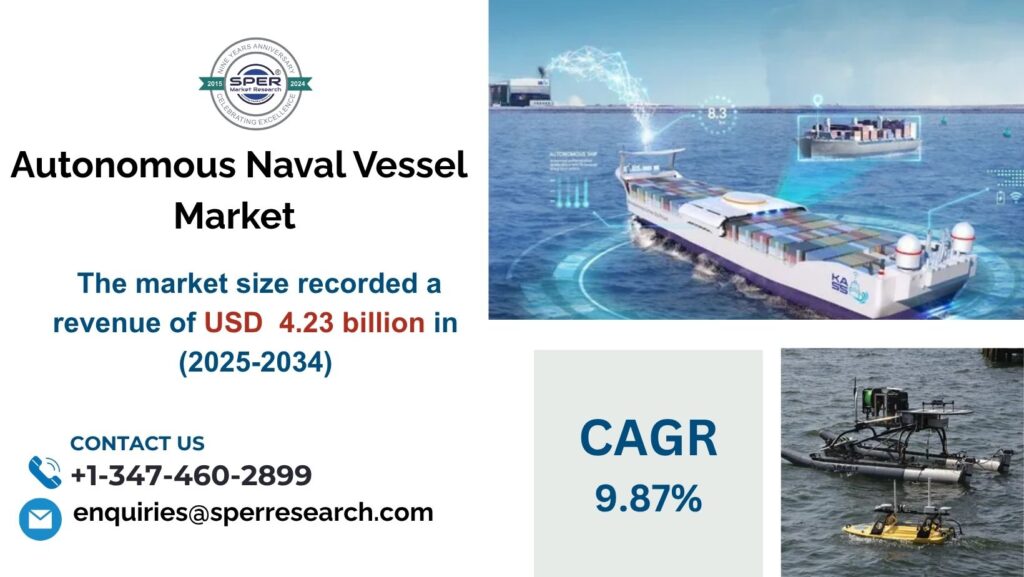Autonomous Naval Vessel Market Trends, Growth, and Forecast

An Autonomous Naval Vessel is an unmanned ship that can navigate and carry out tasks at sea with little to no assistance from humans. Real-time decision-making is based on sophisticated technology including robots, artificial intelligence, sensors, satellite navigation, and automated communication systems. Coastal security, anti-submarine warfare, mine detection, surveillance, reconnaissance, and logistical delivery are just a few of the many tasks that these ships are built to perform. They enhance operational effectiveness by operating either alone or in a fleet with manned naval vessels. Mission endurance is increased, operational costs are decreased, and human life hazards are decreased by autonomous naval boats. They are thus increasingly seen as a revolutionary development in contemporary marine defense that will influence naval security and combat in the future.
According to SPER Market Research, ‘Global Autonomous Naval Vessel Market Size-By Type, By Autonomy, By Vessel Category, By Propulsion Type – Regional Outlook, Competitive Strategies and Segment Forecast to 2034’ state that the Global Autonomous Naval Vessel Market is predicted to reach 4.23 billion by 2034 with a CAGR of 9.87%.
DRIVERS:
The Global Autonomous Naval Vessel Market is primarily driven by growing maritime security concerns, technical improvements, and cost-cutting requirements. Increasing risks such as piracy, smuggling, and territorial conflicts force warships to use unmanned systems for safer and more effective surveillance, reconnaissance, and patrol missions. Rapid advances in artificial intelligence, machine learning, sensor integration, and communication technologies are allowing vessels to operate autonomously with real-time decision-making and sophisticated obstacle avoidance capabilities. Furthermore, autonomous vessels reduce operational costs by reducing crew requirements, reducing the danger of human mistake, and boosting fuel efficiency through smart navigation. Supportive legislative frameworks and rising defense budgets around the world also contribute to demand, as countries seek to expand naval capabilities, improve domain awareness, and gain competitive advantages in contested maritime regions.
Autonomous Naval Vessel Market Sample in PDF Format, Click Here
RESTRAINTS:
A number of significant reasons limit the Global Autonomous Naval Vessel Market. One of the key constraints is the presence of regulatory obstacles. International maritime regulations, naval operation protocols, and safety requirements have not yet been fully adjusted to suit autonomous or unmanned vessels. The lack of explicit frameworks limits deployment speed and hinders integration into active fleets. Another major impediment is the high cost of technology. Developing, building, or retrofitting vessels with advanced technology such as artificial intelligence, automated navigation, and sophisticated sensors demands significant cost, making it impossible for many navies to implement on a broad scale. Furthermore, funding constraints in certain places, as well as the complexities of integrating autonomous vessels into existing defense infrastructure, impede their general adoption and operational extension.
North America dominates the autonomous naval vessel market due to the United States’ heavy defense investments, advanced R&D, and strong presence of leading defense contractors. Some of the major market players are BAE Systems, EXAIL Technologies SA, Kongsberg Maritime, L3Harris Technologies Inc., Lockheed Martin Corporation, Northrop Grumman, Saildrone Inc., SeaRobotics Corporation, Textron Systems Corporation, Thales.
For More Information, refer to below link: –
Autonomous Naval Vessel Market Growth
Related Reports:
Aerospace & Defense Thermal Management Systems Market
Follow Us –
LinkedIn | Instagram | Facebook | Twitter
Contact Us:
Sara Lopes, Business Consultant — USA
SPER Market Research
enquiries@sperresearch.com
+1–347–460–2899





